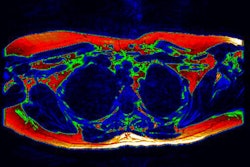Researchers at the Massachusetts Institute of Technology (MIT) in Boston have invented an injectable device that uses MRI to determine oxygen levels in cancer tumors.
Since cancer cells thrive when deprived of oxygen, measuring oxygen levels in tumors could help doctors make treatment decisions. Current methods to determine oxygen levels are unreliable, and there are noninvasive ways to make such measurements, according to the study published online April 21 in Proceedings of the National Academy of Sciences.
The research, led by Michael Cima, MIT professor of engineering, uses contrast agents, magnetic fields, and radio waves to interact with protons to produce detailed images of the body's interior.
The imaging technique combines two forms of silicone -- a solid called (PDMS) and a substance known as DDMPS, which has an oily consistency. The oily DDMPS can be dissolved in PDMS, creating what's called a "swollen polymer."
The polymer is shaped into a 1.5-mm sensor that can be implanted in tissue during a biopsy along with smaller particles that can be injected through a needle. After injection, these particles clump together to form a solid sensor.
To test the sensors, researchers implanted them in the hind legs of rats and then measured how the signal changed as the rats breathed pure oxygen, regular air, and pure oxygen again. The sensors detected changes in oxygen pressure as small as 15 mm Hg, and it took less than 10 minutes to see the effects of a change in inhaled gas.
When the experiment was repeated four weeks later, the sensors yielded the same results. Thus Cima and colleagues believe the sensor is a novel way to potentially track how cancer patients respond to treatment.
The researchers also believe the sensor could also be useful for monitoring blood flow in patients with diabetes.


.fFmgij6Hin.png?auto=compress%2Cformat&fit=crop&h=100&q=70&w=100)





.fFmgij6Hin.png?auto=compress%2Cformat&fit=crop&h=167&q=70&w=250)











